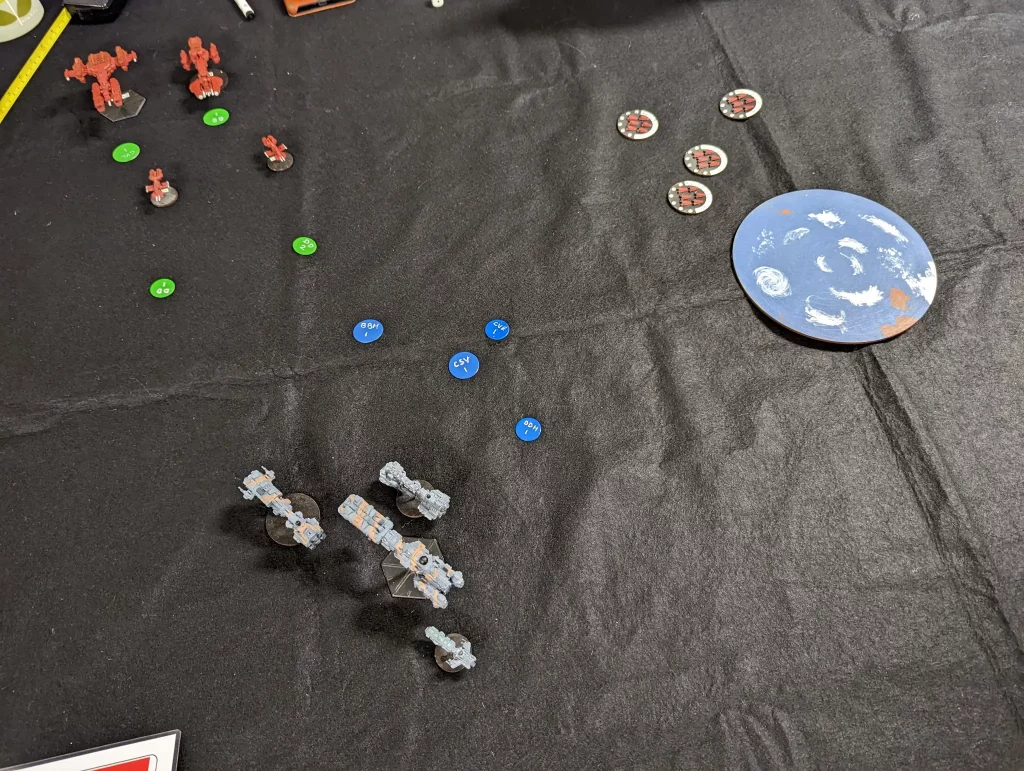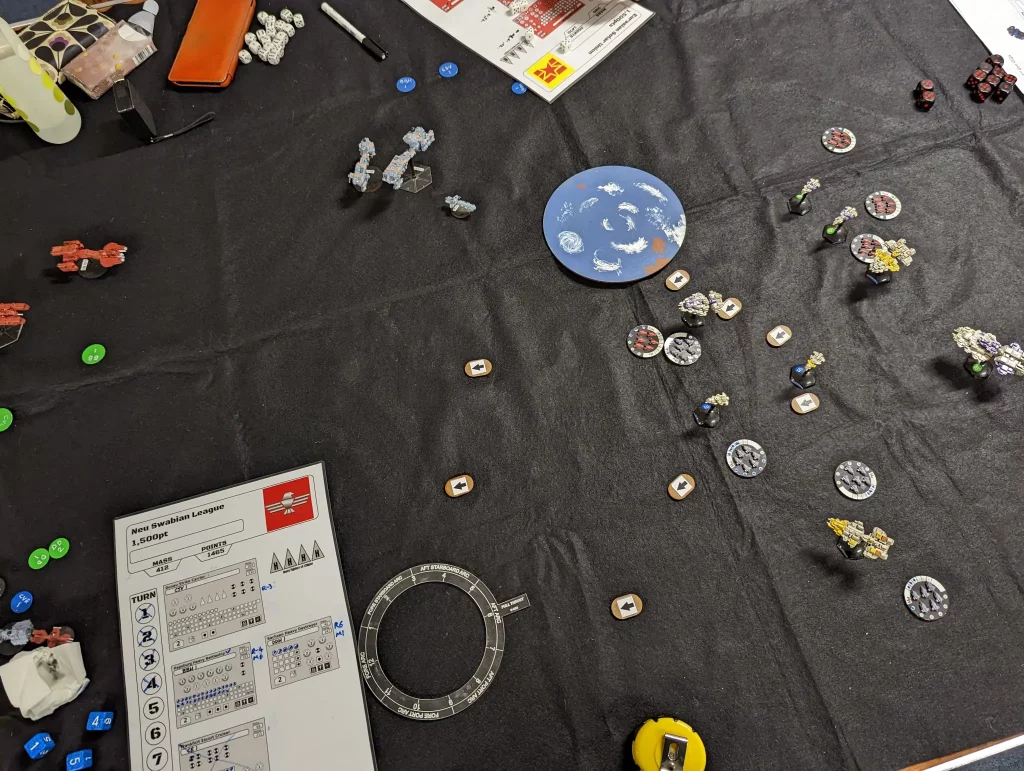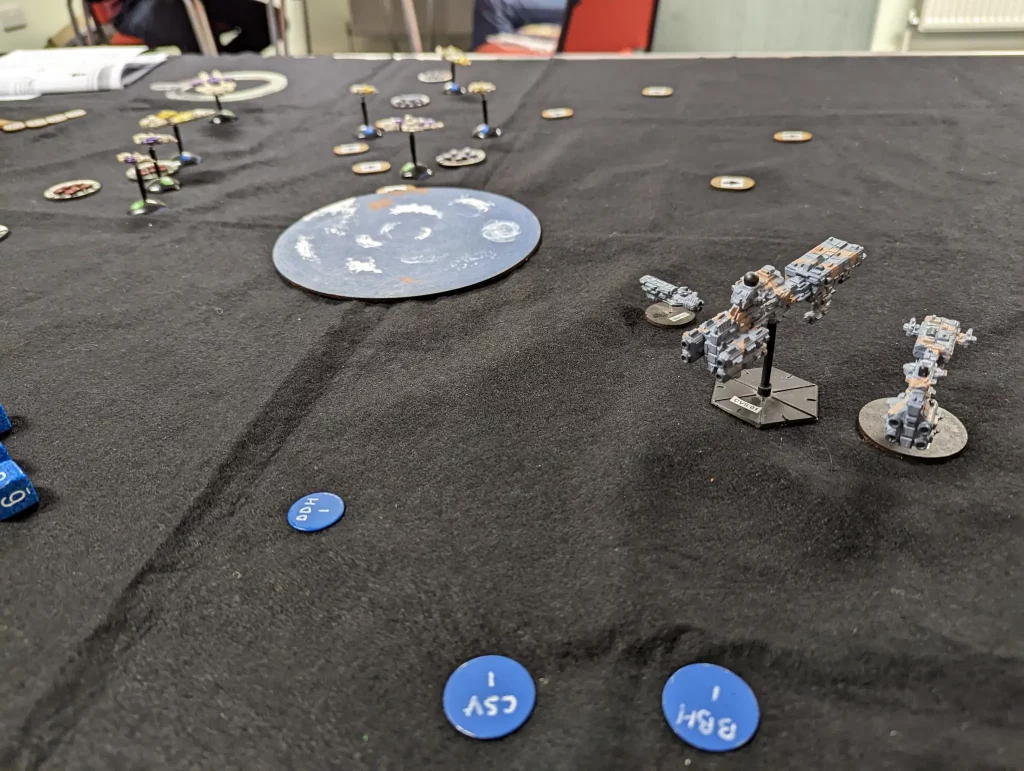Battle of Three Fleets
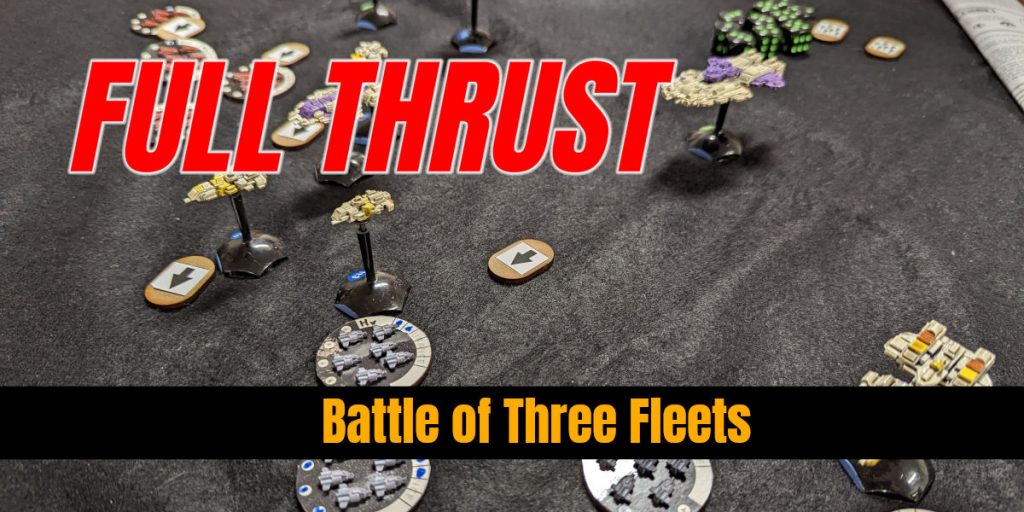
We had another chance to play Full Thrust at FWGS last night, with a three player battle between the Neu Swabian League (NSL), Eurasian Solar Union (ESU) and Federal Stats Europa (FSE). Previously, our Full Thrust games have involved me designing each of the fleets and I’ve gone for relatively balanced fleet designs. This time though only two of the fleets were mine, the third was put together by someone else so was a very different fleet structure.
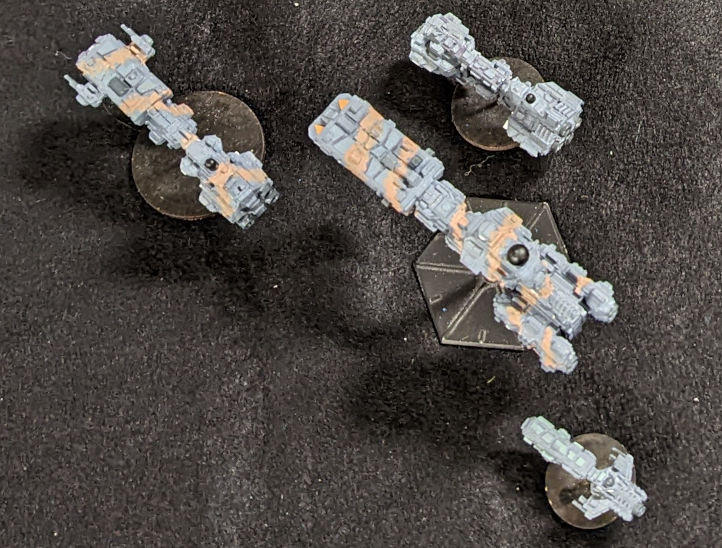
Everyone had 1,500pts to spend. The NSL and ESU fleets each consisted of two capital ships plus a couple of smaller vessels. The NSL had:
- Donau Strike Carrier (160 mass, 534pts), plus 4 heavy fighters
- Hapsburg Heavy Battleship (142 mass, 453pts)
- Frankfurt Escort Cruiser (68 mass, 211pts)
- Sachsen Heavy Destroyer (42 mass, 147pts)
For the ESU, there was:
- Changchun Light Carrier (182 mass, 637pts), plus 4 heavy fighters
- Khalinov Battleship (140 mass, 489pts)
- 2x Ural Destroyers (34 mass, 112pts)
The FSE fleet had by far the largest number of ships, with nothing larger than a heavy cruiser. There were several corvettes and frigates. The individual ships actually used my designs from my website, but the fleet structure was very different to what the ESU and NSL were fielding.
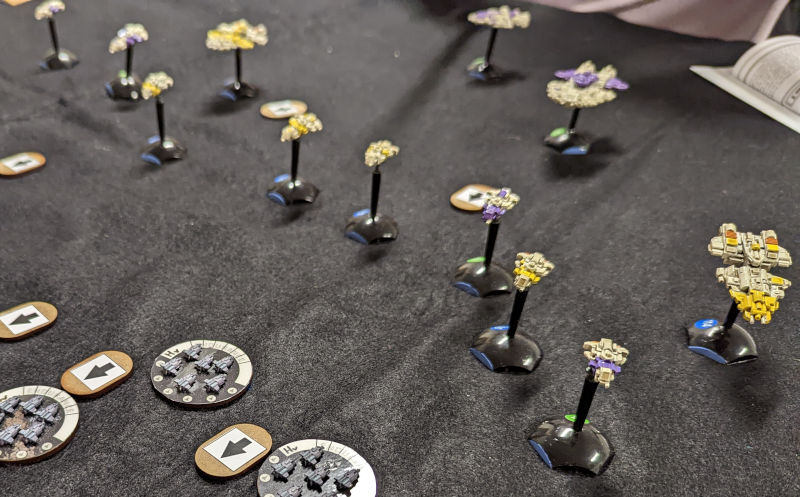
The design doctrine I’d used for both the ESU and NSL was for heavily armed and heavily armoured ships, with very limited manoeuvrability. Most ships for both both these fleets had a maximum thrust of 2, with a couple getting as high as 4. The NSL had large amounts of armour, and the ESU had class 4 beam batteries which gave them incredibly long range.
The FSE had fast and manoeuvrable ships (mostly thrust 6), with comparably lighter hulls and most weapons were limited to class 2 beams with some salvo missiles. It was going to be interesting to see how the different design styles compared.
The battle opened with the ESU and NSL launching their fighters and starting to move towards each other. The NSL heavy battleship opened up on the ESU ships but failed to do much damage. The ESU returned fire against the Frankfurt, taking out its armour and first row of hull.
The NSL fighters headed towards the FSE (to the right), which the ESU fighters moved around the planet. The FSE was out of range of everyone, and begun a constant move towards the NSL’s rear though.
From my (NSL) perspective, the ESU’s main advantage was that it had class 4 beams (range of 48″), so getting closer would benefit me more. The way beam weapons work, is that the larger weapons have longer range, but are less effective at close range.
The Khalinov for example has 6 class 4 beam weapons, all facing forward. They beat class 2 weapons at long ranges, but are out classed at shorter ranges.
- Six class 4 beam weapons with a total mass of 48 and fire arc of 30°. Does 24 dice damage out to 12″, and 18 dice damage out to 24″. They do 12 dice out to 36″ and 6 dice out to 48″.
- 24 class 2 beam weapons also have a total mass of 48 and a fire arc of 180°, Does 48 dice damage out to 12″, and 24 dice damage out to 24″.
The NSL fleet was mostly a mix of class 2 and 3 beams, so we were going to be hitting harder once we got within closer range. There’s also a greater chance of being able to avoid the fire arcs of the larger weapons.
On the second turn, the Hapsburg split its fire between the two Ural class destroyers, but failed to take either out. The NSL fighters also began to engage the FSE, rolling badly but taking out one of the corvettes. The FSE designs have a number of ships carrying area defence systems, allowing them to aid each other in defence against fighters. My heavy fighters stood up well to the anti-fighter defences though, and no casualties were taken there.
The FSE continued their relatively slow approach, so were still out of range at this point. The ESU fighters were hanging back and not engaging anything.
By turn three, the NSL managed to take out the two ESU destroyers. That reduced the ESU’s ability to do damage. However, the ESU took out my escort cruiser. This didn’t have much in the way of offensive capability, but had 10 PDS (anti-fighter point defence) with area defence fire controls. This greatly reduced the NSL fleet’s ability to defend itself against both fighters and salvo missiles.
As we moved into turn four, the ESU fighters had begun to engage the FSE on their right flank, whilst the NSL fighters were taking out their smaller vessels on the left flank. However, the FSE was coming within range of the ESU’s longer range weapons, and found themselves a target.
The NSL battleship had taken a lot of damage from the ESU, but it still hadn’t lost a hull row. The NSL uses three hull row designs (extra 50% cost to hull), so can take an awful lot of damage before having to make threshold critical checks. We had also turned around and were firing back at both the ESU and FSE.
My original plan was to head around the planet, doing what damage I could to the ESU and then engage the FSE on their right flank, leaving the left flank of the FSE to take on the ESU. However, the FSE was moving everything around the other side of the planet, so the NSL was gradually moving away from the action. Their low thrust makes changing plans mid-game difficult.
The ESU player was trying to keep at long range to everyone, making use of her long range weapons. This suited the design of the ESU fleet well.
The FSE though was still at long range to everyone, and still hadn’t managed to get within range to use their salvo missiles. At long range, they were being picked off by the bigger beam weapons, and were losing ships to the fighters.
The point defences were beginning to take their toll on the fighter groups though. One NSL fighter group was lost, and the NSL also decided to engage the ESU fighters, taking out one of their groups. All the fighter groups had taken losses though. I think the FSE’s heavy use of area defence systems was working, though possibly not as quickly as they’d like.
As we moved into turns five and six, it became more of a battle between the ESU and FSE. The NSL continued to hammer the ESU’s Khalinov Battleship, which was taking threshold checks, and some of the longer weapons of the ESU (some class 3s) were beginning to come into play.
However, the FSE wasn’t closing fast enough. They lost both their salvo missile launchers to critical hits, then managed to repair them both. Finally, they got into range, but got poor rolls on the dice, launching two salvos at the Khalinov.
By this point the area defence from the Changchun carrier came to the rescue, and all the salvo missiles were destroyed. By this point there wasn’t much left of the FSE. The NSL were drifting off the board (they could have stayed on if they’d wanted to, but were more interested in recovering their fighters at this point).
The game was probably mostly a draw between the NSL and ESU, with the edge to the ESU since they were mostly present.
For the FSE, it was a crushing defeat. I think a number of factors didn’t work in their favour:
- It was their first time playing in a long time, and the vector movement system was completely new to them.
- In Full Thrust, bigger ships are more capable than lots of smaller ships. A couple of points of damage to a small ship can start knocking out weapon systems, whilst it takes a lot of damage to do the same to capital ships (especially if they are heavily armoured).
- They had short and medium range weapons, compared to the longer ranged weapons of the ESU.
- They lacked any fighters, so couldn’t take the battle to their opponents.
- They had a lot of mass tied up in drive systems, but didn’t make much use of it, so it was effectively wasted mass.
The last point is probably the most interesting. Would things have been different if they’d accelerated harder and closed the range quickly? They definitely could have sandwiched the NSL between themselves and the ESU, which would have been bad for me.
With the ESU close to the board edge, deceleration becomes a problem. Maybe we should use a bigger game area, or make use of a rolling board, to allow more manoeuvrable ships a bit more latitude. A fast flyby attack could have done damage, possibly before they’d taken heavy losses, even if it meant going off the board.
Another option may have been to change direction and head clockwise around the planet, to catch the NSL as they tried to use it as a shield. They could possibly have made better use of their thrust to evade fighter attacks. Especially their thrust 8 corvettes could have forced both the ESU and NSL to expend more fighter endurance when attacking, reducing the time we spent in combat. As it was, the ESU were quite close to their endurance limit by the time they pulled back.
For the big ship v small ship problem, there is an alternative way to derive point costs for ships, which makes larger ships more expensive. But a simpler option of limiting capital ships to 50% of the point cost of the fleet might work as well.
One suggestion that was made for the larger weapons, was that maybe they shouldn’t be able to target smaller ships. It makes sense from a wet navy perspective, but with advanced fire control systems and speed of light energy weapons I can see an argument that there’s nothing stopping a big laser gun targeting escort vessels. From a game balance and interest of design perspective though, it might make sense.
Maybe a class 3 can’t target anything smaller than mass 30, and a class 4 can’t target anything less than mass 60 (or maybe masses 25 and 50). That does raise the question of how other weapons are affected by this – pulse torpedoes, railguns, grazers etc. It’s something we’d have to think about.
The scenario was meant as a simple meeting engagement, with no real agenda other than destroy as much of the enemy as possible. I hadn’t come up with a proper scenario because I wasn’t certain what type of fleet the FSE was going to consist of, so didn’t want to create a scenario that wouldn’t have been suitable. However, something like taking control of the planet may have benefited the FSE. They had the manoeuvrability to reach the planet and stay there, possibly even using it as cover. This would have forced both the ESU and NSL to come to them, rather than allowing those fleets to hang back and stay out of close combat.
The game definitely gave me something to think about in terms of my various fleets and how they compare to each other. They were designed maybe 10 years or so ago, mostly as a theoretical exercise and haven’t had much use. There’s some tweaks I’d like to make to the NSL smaller ships (make them a bit faster), and maybe the FSE need some longer range weapons.
I think I’d also like to try a fleet of smaller fast ships and see how they work if played more aggressively. They might simply blow up quicker, but the only way to find out is to give it a go.
